Interior Lighting Market Research, 2032
The global interior lighting market was valued at $79.5 billion in 2022, and is projected to reach $130.3 billion by 2032, growing at a CAGR of 5.1% from 2023 to 2032.
Report Key Highlighters
- The report provides competitive dynamics by evaluating business segments, product portfolios, target market revenue, geographical presence and key strategic developments by prominent manufacturers.
- The interior lighting market is fragmented in nature among prominent companies such as Jaquar Group., Wipro Lighting, Kichler lighting, Trilux GmbH and co. kg, Est Lights, WLS Lighting Systems, Inc., Lena Lighting S.A., Karice Lighting, Russell Lighting, and ERCO GmbH.
- The study contains qualitative information such as the market dynamics (drivers, restraints, challenges, and opportunities), key regulation analysis, pricing analysis, and Porter’s Five Force Analysis across North America, Europe, Asia-Pacific, LAMEA regions. Moreover, the report covers sub-segments that is studied across all the regions.
- Latest trends in global interior lighting market such as undergoing R&D activities, regulatory guidelines, and government initiatives are analyzed across 16 countries in 4 different regions.
- More than 3,600 interior lighting-related product literatures, industry releases, annual reports, and other such documents of key industry participants along with authentic industry journals and government websites have been reviewed for generating high-value industry insights for global interior lighting market.
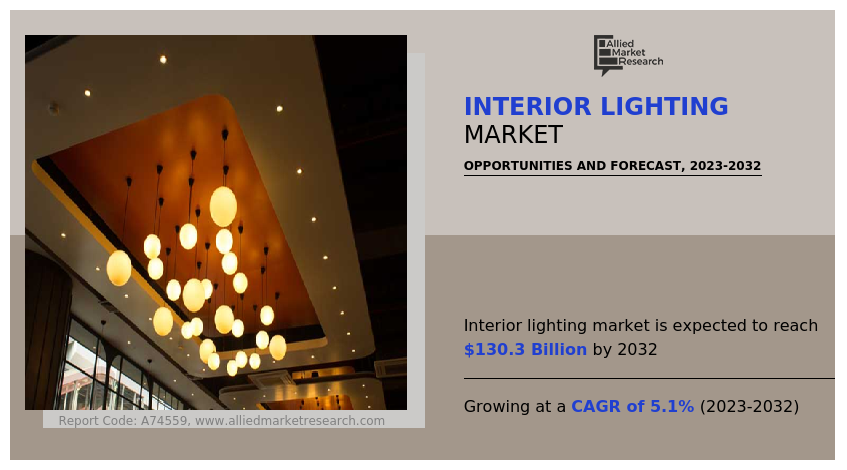
Interior lighting plays a pivotal role in enhancing the aesthetics, functionality, and ambiance of indoor spaces. Lighting design encompasses different techniques and fixtures including the soft glow of a bedside lamp to the vibrant illumination of a grand chandelier. Lighting fulfills various practical requirements in interior design. The primary purpose of lighting is to provide adequate illumination in a space and proper lighting design which ensures that each area is appropriately illuminated for its intended purpose. Adequate illumination ensures visibility, safety, and efficiency in daily activities, while well-designed lighting schemes create specific moods, highlight architectural features, and influence occupants' psychological well-being. Interior designers can manipulate space, shape perception, and evoke desired atmospheres by harnessing the power of light.
Interior lighting encompasses a broad spectrum of techniques and fixtures, including ambient lighting, task lighting, accent lighting, and decorative lighting. Ambient lighting provides overall illumination and sets the general tone of a space. This can be achieved through ceiling-mounted fixtures, recessed lights, or natural light sources such as windows and skylights. Task lighting, on the other hand, focuses on specific activities and requires higher intensity. It is commonly found in areas like kitchens, offices, and reading nooks, using fixtures like pendant lights, desk lamps, or under-cabinet lights. Accent lighting aims to highlight architectural elements, artwork, or decorative objects, creating focal points and visual interest. Track lights, wall-mounted fixtures, and adjustable spotlights are commonly used for accent lighting. Lastly, decorative lighting serves as a statement piece, adding flair and personality to interiors.
The versatile nature of interior lighting allows it to be employed in a multitude of settings, catering to diverse requirements and design objectives. Lighting can create a warm and inviting ambiance in living rooms, and functional and well-lit environments in kitchens and bathrooms in residential spaces. Residents can adapt the lighting to different activities or moods, enhancing their overall living experience by using dimmers and control systems.
Commercial spaces greatly benefit from strategic lighting design. Retail stores utilize lighting to showcase products, create visual hierarchy, and guide customers through space. Bright, well-lit areas draw attention to merchandise, while softer lighting in changing rooms contributes to a relaxed atmosphere. Offices require task lighting to ensure productivity and reduce eye strain, often employing a combination of natural and artificial light sources. Dynamic lighting systems that mimic natural daylight can enhance employee well-being, productivity, and concentration.
Hospitality venues, such as hotels and restaurants, heavily rely on lighting to establish their desired ambiance. Lighting can evoke a sense of luxury, comfort, or excitement, depending on the establishment's theme. Restaurants may use warm, low-level lighting to create an intimate dining experience, while hotels might employ a combination of functional and decorative lighting to establish a welcoming atmosphere in lobbies and guest rooms.
Educational institutions recognize the impact of lighting on students' learning experiences. Well-lit classrooms with appropriate levels of lighting contribute to improved concentration, focus, and overall academic performance. Similarly, museums and art galleries carefully design lighting schemes to enhance the visibility and aesthetics of exhibited artworks while preserving their integrity.
The interior lighting is segmented into type, product, lighting effect, end-use industry and regions. On the basis of type, the market is divided into general lighting, ambient lighting, task lighting, mood lighting, and accent lighting. On the basis of product, the market is classified into decorative lamps, ceiling lights, pendant lights, chandeliers, wall lights, clamp lights, spots and spotlights, step lights, track lights, recessed and surface-mounted lights, and others. On the basis of lighting effect, the market is categorized into downlighting, uplighting, wall washing, wall grazing, spotlighting, perimeter lighting, and others. On the basis of end-use industry, the market is divided into residential, commercial, and others. Region-wise the market is segmented into North America, Europe, Asia-Pacific, and LAMEA.
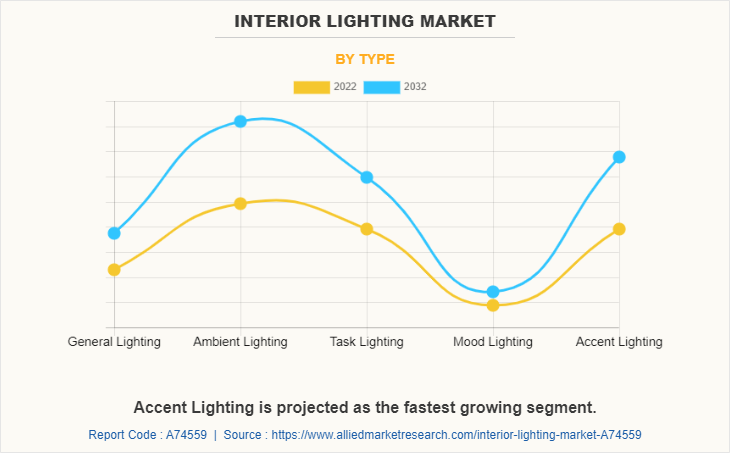
On the basis of type, the ambient lighting segment dominated the interior lighting market in 2022. Ambient lighting is the general illumination within an area that produces a welcoming and pleasant feel. It can also refer to the lighting design and fixtures utilized to produce overall illumination in a space or region. The fundamental goal of ambient lighting is to provide a consistent degree of light across the space, preventing glaring contrasts and harsh shadows. It establishes the general mood and tone of the area, making it appropriate for a variety of activities while also generating a welcome ambience.
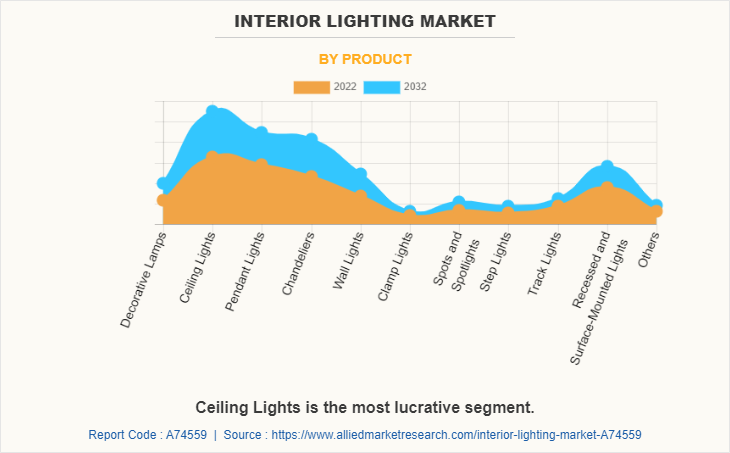
On the basis of product, the ceiling lights segment dominated the interior lighting market in terms of revenue in 2022. Ceiling lights are available in a variety of styles and designs to meet a variety of aesthetic and functional needs. Flush mount ceiling lights are popular because of their smooth and compact appearance, which makes them excellent for spaces with low ceilings or minimalist designs. Semi-flush mount lights are a lower hanging option that adds visual flair without being too noticeable. Pendant lights, on the contrary, produce a suspended look and are available in a variety of shapes and sizes, providing both functional and ornamental reasons. Chandeliers, which are noted for their beauty and richness, include many branches or arms that are embellished with decorative features and are frequently utilized as focal points in large settings.
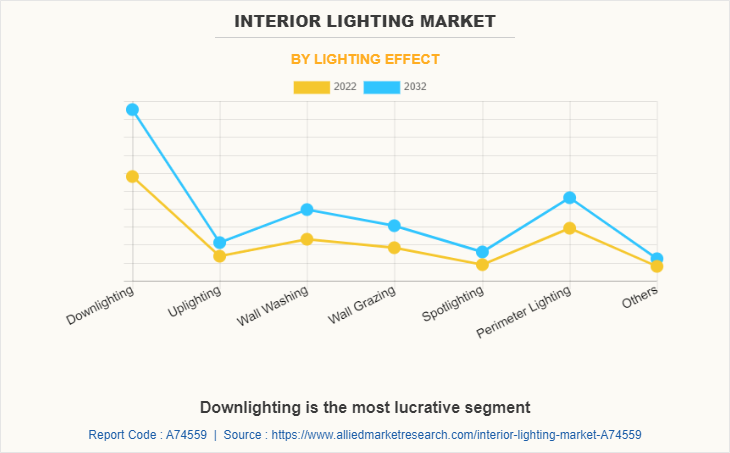
On the basis of lighting effect, the downlighting segment dominated the interior lighting market in terms of revenue in 2022. Downlighting is a lighting technology that is widely employed in the interior lighting industry. It entails installing light fixtures in such a way that the light is directed downward, generating focused and localized illumination. Typically, the fixtures are situated on the ceiling or high on the walls and are designed to cast light downward, accentuating specific regions or things in a space.
Downlighting can be accomplished using a variety of light fixtures, including recessed lights, track lights, and pendant lights. The light beam from these fixtures is tilted downward, giving task lighting or ambient lighting to specific regions of a room.
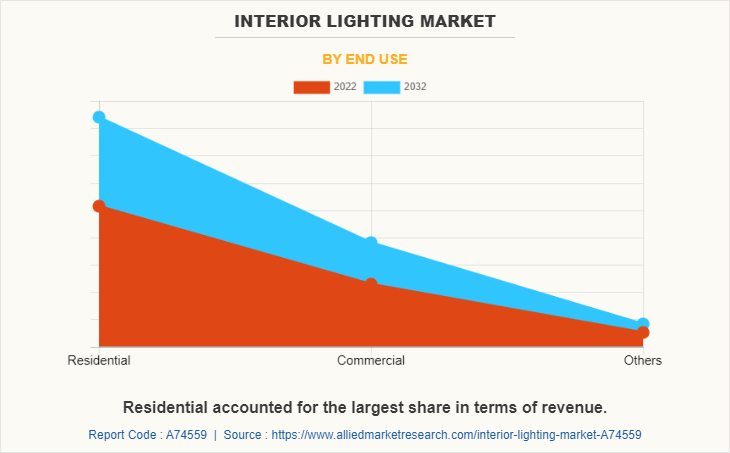
On the basis of end-use industry, the residential segment dominated the interior lighting market in terms of revenue in 2022. Residential lighting fixtures and systems are those used in homes, apartments, condominiums, or any other sort of residential dwelling. Residential end-use lighting illuminates numerous parts of a home, such as living rooms, bedrooms, kitchens, bathrooms, corridors, and outdoor spaces such as gardens or patios. These lighting fixtures are custom-made to fulfil the practical, aesthetic, and ambience needs of home environments.
Overhead or ceiling lights, wall-mounted fixtures, table lamps, floor lamps, pendant lights, track lighting, recessed lighting, and decorative lighting alternatives are all available in the home end-use lighting market. These fixtures are available in a variety of designs, sizes, colors, and lighting technologies (such as incandescent, fluorescent, and LED) to accommodate diverse homeowner preferences and lighting demands.
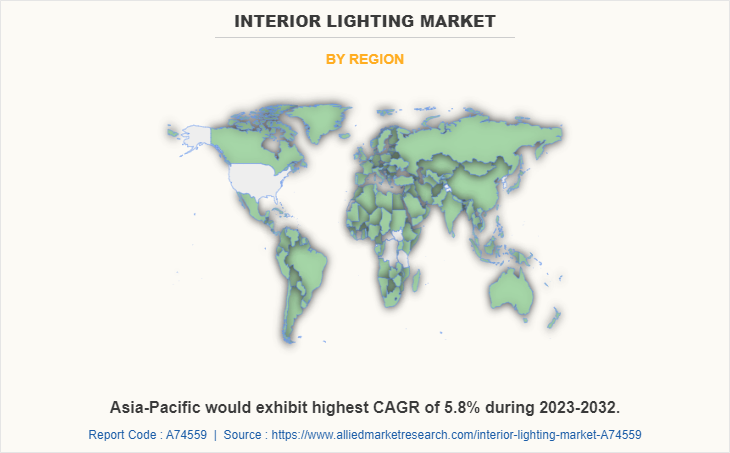
Region wise, Asia-Pacific region dominated the interior lighting market share in 2022. The Asia-Pacific area is rapidly urbanizing and developing infrastructure. According to the World Bank, East Asia and the Pacific are the world's fastest urbanizing regions, with an annual urbanization rate of 3% on average. Interior lighting solutions are in high demand as new residential, commercial, and public infrastructure projects require efficient and visually acceptable lighting to enhance inside environments.
LED lighting is gaining popularity in the Indian market. The government's energy-efficiency programs, such as the Unnat Jyoti by Affordable LEDs for All (UJALA) plan, have been critical in driving the use of LED lighting. Due to its energy efficiency, longer lifespan, and cost-effectiveness, LED lighting has a high market penetration rate and has essentially displaced traditional lighting solutions.
Technological advancements as smart lighting and integration drive the growth of the interior lighting market. Interior lighting plays a vital role in enhancing the functionality, aesthetics, and ambiance of indoor spaces. It ensures proper visibility and functionality, allowing individuals to perform tasks efficiently. Ambient lighting provides overall illumination, while accent lighting highlights architectural elements or points of interest. Adequate lighting levels and balanced distribution are essential to meet both functional and aesthetic requirements.
In addition, emerging trends in interior lighting include smart lighting systems that offer remote control and personalized settings, human-centric lighting that mimics natural daylight patterns, and the use of organic light-emitting diodes (OLEDs) for innovative applications. It is important to consider energy efficiency in interior lighting design, utilizing energy-efficient light sources and advanced lighting control systems to reduce environmental impact and save costs. Overall, interior lighting is a dynamic field that continues to evolve with technological advancements and design trends, shaping the future of illuminated spaces.
Thus, high initial cost is expected to hinder the interior lighting market growth during the forecast period. LED lights are renowned for their energy efficiency and long lifespan, although they may have a higher upfront cost compared to traditional lighting options. However, the advantages of LED lighting justify the initial investment. LED lights consume less energy, resulting in reduced electricity bills and long-term cost savings. Their extended lifespan reduces maintenance and replacement expenses.
Furthermore, LED lights emit less heat, making them safer and more comfortable for interior use. Smart lighting systems offer additional benefits by allowing remote control via smartphone apps or voice commands. Though the initial cost of smart lighting may be higher, the features it provides, such as dimming, color changing, and scheduling, enhance the ambiance and convenience of spaces. Integration with other smart home devices promotes energy efficiency and customization. Over time, the cost of LED and smart lighting solutions is expected to decrease, further incentivizing their adoption.
The major players operating in the interior lighting market include Jaquar Group., Wipro Lighting, Kichler lighting, Trilux GmbH and co. kg, Est Lights, WLS Lighting Systems, Inc., Lena Lighting S.A., Karice Lighting, Russell Lighting, and ERCO GmbH.
Historic Trends
In the late nineteenth and early twentieth centuries, the Art Nouveau movement influenced lighting design. Artists and designers like Louis Comfort Tiffany created intricate stained glass lamps, featuring organic motifs and vibrant colors. Tiffany lamps became highly sought after and remain iconic.
In 1970, Edmund Germer, Friedrich Meyer, and Hans-Joachim Gores from Germany's General Electric develop the first practical compact fluorescent lamp (CFL). CFLs utilize a fluorescent coating on the inside of a small spiral or folded glass tube, which is filled with a mixture of inert gases and a small amount of mercury vapor.
In early 2000s, light-emitting diodes (LEDs) continue to advance, with improvements in color range, brightness, and efficiency. LED lighting becomes affordable and widely used in various interior lighting applications. Light-emitting diodes (LEDs) continue to improve in terms of color range, brightness, and energy efficiency.
In 2012, LED driver technology made significant strides in addressing these issues. LED drivers were developed with improved circuitry, control algorithms, and compatibility with standard dimmer switches commonly used in homes and commercial spaces. The advancements allowed for smoother and more precise dimming of LED lights, creating a comfortable and customizable lighting experience.
Key Benefits For Stakeholders
- This report provides a quantitative analysis of the market segments, current trends, estimations, and dynamics of the interior lighting market analysis from 2022 to 2032 to identify the prevailing interior lighting market opportunities.
- The market research is offered along with information related to key drivers, restraints, and opportunities.
- Porter's five forces analysis highlights the potency of buyers and suppliers to enable stakeholders make profit-oriented business decisions and strengthen their supplier-buyer network.
- In-depth analysis of the interior lighting market size, segmentation assists to determine the prevailing market opportunities.
- Major countries in each region are mapped according to their revenue contribution to the global market.
- Market player positioning facilitates benchmarking and provides a clear understanding of the present position of the market players.
- The report includes the analysis of the regional as well as global interior lighting market trends, key players, market segments, application areas, and market growth strategies.
Interior Lighting Market Report Highlights
| Aspects | Details |
| Market Size By 2032 | USD 130.3 billion |
| Growth Rate | CAGR of 5.1% |
| Forecast period | 2022 - 2032 |
| Report Pages | 698 |
| By Lighting Effect |
|
| By End Use |
|
| By Type |
|
| By Product |
|
| By Region |
|
| Key Market Players | WLS Lighting Systems, Inc., ERCO GmbH, Wipro Lighting, Karice Lighting, Lena Lighting S.A., Kichler Lighting, LLC, Russell Lighting, Trilux Gmbh, Jaquar Group., Est Lights |
Analyst Review
According to CXOs, the interior lighting market is poised for significant growth in the coming years. This growth can be attributed to several factors, including the increase in demand for innovative and energy-efficient lighting solutions in residential, commercial, and industrial spaces such as warehouses & cold storage.
CXOs believe that the interior lighting market is projected to witness high traction due to the surge in awareness among individuals and businesses regarding the impact of lighting on aesthetics, ambiance, and overall comfort. Well-designed and properly implemented interior lighting solutions not only enhance the visual appeal of spaces but also contribute to creating a productive and inviting atmosphere.
The interior lighting market is expected to experience rapid expansion driven by the surge in construction activities, infrastructure development, and urbanization worldwide. There is a growing need for versatile and customizable lighting solutions that can meet the diverse requirements of different spaces and architectural designs with increase in renovations and construction of residential and commercial buildings.
Government initiatives promoting energy efficiency and sustainability also play a crucial role in driving the adoption of interior lighting solutions. Many countries are implementing regulations and standards that encourage the use of energy-efficient lighting technologies such as LED with a focus on reducing energy consumption and carbon emissions.
CXOs emphasize that leading market players have responded to the rise in demand by introducing advanced interior lighting solutions that combine aesthetics, functionality, and energy efficiency. These lighting fixtures are designed to provide optimal illumination, flexibility, and control options to cater to the evolving needs and preferences of consumers.
In terms of regional opportunities, the interior lighting market holds promising prospects in regions such as North America, Europe, and Asia-Pacific. These regions are witnessing rapid urbanization and infrastructure development, driving the demand for interior lighting solutions in residential, commercial, and hospitality sectors.
However, CXOs also acknowledge that challenges exist in the interior lighting market. One significant challenge is the need to educate customers about the long-term cost benefits of investing in energy-efficient lighting solutions. Many customers may focus on the initial cost and overlook the potential savings and environmental advantages that come with energy-efficient lighting technologies.
Technological advancements as smart lighting and integration and increase in construction and infrastructure development are the upcoming trends of interior lighting market.
Residential and commercial are the leading application of interior lighting market.
Asia-Pacific is the largest regional market for the interior lighting market.
The interior lighting market valued for $79.4 billion in 2022 and is estimated to reach $130.3 billion by 2032, exhibiting a CAGR of 5.1% from 2023 to 2032.
as Jaquar Group., Wipro Lighting, Kichler lighting, Trilux GmbH and co. kg, Est Lights, WLS Lighting Systems, Inc., Lena Lighting S.A., Karice Lighting, Russell Lighting, and ERCO GmbH are the top companies to hold the market share in the interior lighting market.
Loading Table Of Content...
Loading Research Methodology...



